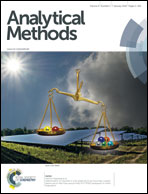Enrichment and analysis of typically persistent organic pollutants at trace level using micro-solid phase extraction based on titanium dioxide nanotube arrays
Abstract
In present study, a micro-solid phase extraction with highly ordered titanium dioxide nanotube arrays as the adsorbent was developed for the enrichment and determination of eight persistent organic pollutants including heptachlor, heptachlor-epoxide, α-endosulfan, dieldrin, endrin, β-endosulfan, endosulfan sulfate and methoxychlor. The optimal conditions were as follows: elutant solvent, dichloromethane; cetyltrimethyl ammonium bromide (CTAB), 900 μL; extraction time, 40 min; desorption time, 5 min: sample pH, pH 7. The results showed that eight target persistent organic pollutants were successfully enriched and good limits of detection in the range of 0.018–0.19 μg L−1 were achieved. The precision of the proposed method was in the range 4.6–8.5% (RSD, n = 6). Analysis of genuine environmental water samples resulted in good spiked recoveries in the range of 75.1–107%. Based on these results, the titanium dioxide nanotube array demonstrated its advantages for enrichment and separation, and we predict it will be of great value in the development of new preconcentration and determination methods for other pollutants.


 Please wait while we load your content...
Please wait while we load your content...